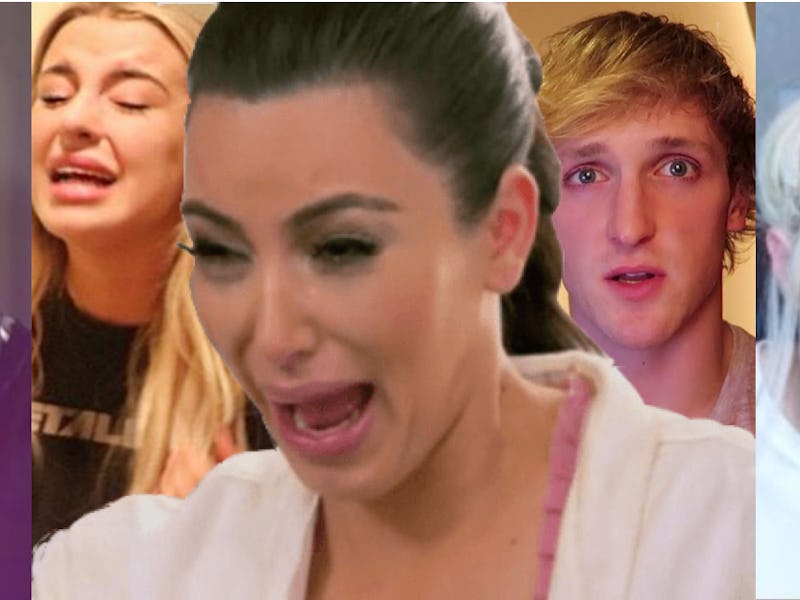TanaCon Is the Latest Real-life Consequence of the Streaming Economy
Tana Mongeau's future, and maybe ours, too, is in the hands of her subscribers.

Tana Mongeau, the 20-year-old “STORYTIMES” YouTuber, has made a career off of entertaining a legion of young fans via Internet shenanigans. It’s a tale as old as YouTube itself — 13 years.
As the landmark streaming service reaches teenager status, the YouTube community has developed its own industry fueled by tweens and teens buying merchandise, watching ads, and going to tours, meet-and-greets, and conventions. YouTube itself doesn’t allow for the type of monetization that its creators want, so creators are mobilizing their massive followings in off-platform ways that sometimes result in equally massive failures.
Mongeau, whose claims to fame have included getting arrested at Coachella, entering a polyamorous relationship with former Disney Channel star Bella Thorne, launching a rap career, and gaining 3.6 million YouTube subscribers, reached a breaking point over the last two months with the rise and devastating fall of TanaCon.
Her failed quest to create an alternative gathering in opposition to the mainstream, YouTube-endorsed VidCon convention is a stark reminder that the cultural phenomenon of social media stardom is fraught with consequences for both fans and creators, and maybe the way society operates at large.
Why Did TanaCon Fail?
The planned YouTuber convention centered around Mongeau spawned from, naturally, a STORYTIMES video titled “Why I Won’t Be Attending Vidcon 2018: A Rant” that featured the creator screaming, cursing, whining, and damning VidCon for their alleged cycle of lies and manipulation that led to Mongeau being permanently banned from the annual event.
VidCon was developed by the “vlogbrothers” John and Hank Green. The former is the mega-bestselling young adult fiction writer of The Fault In Our Stars, and he and his brother are also arguably the founding fathers of the YouTube community.
The Greens have championed educational YouTube channels that play in high school classrooms across the country, created a platform for YouTubers to make money beyond ad monetization, and founded the OG internet celebrity convention in Anaheim, California for YouTubers, Viners, Musical.ly stars, Instagram influencers, and all manner of digital personalities, to meet their fans.
Now on its seventh iteration, VidCon hosted 30,000 attendees this year with a security budget of over $1 million and a million square foot-sized arena for its hundreds of “featured creators,” beauty gurus, comedians, and pranksters. But not Mongeau. As legacy YouTuber Shane Dawson (he’s only 29-years-old, but that’s midlife in YouTube years) chronicled in his three-part, almost two-hour TanaCon documentary series, which has now racked up almost 30 million views, Mongeau and her team were woefully unprepared and naively ambitious in believing they could host a VidCon competitor the same weekend in the same city in a Marriott hotel ballroom with over 5,000 attendees.
As Dawson maps out in his series, the capacity of the venue could barely hold over a thousand attendees, despite Good Times Live selling nearly 5,000 tickets, grossing $325,000. On the actual day of TanaCon, a line of thousands filled the hotel’s parking lot as the event quickly careened towards disaster. Eventually, fans posted critical vlogs and live-streamed garish sunburns and laughable VIP gift bags.
Who Else in the YouTube Community Has Revolted?
The streaming economy has seen plenty of misfortunes in the decade before TanaCon. Rarely is any social media star successful without public controversy, and plenty of business ventures have died off or failed to even take off. For every beauty guru cosmetics line there’s an app like Vine that couldn’t sustain itself. Some vloggers make careers out of their content when others return to their day jobs. The Paul brothers made record subscriber gains with their “Everyday, bro!” mantra but have become a synonym for cringeworthy.
On a more serious level of consequence, channels like DaddyOFive have had their stars lose custody for child abuse. YouTube Kids has been emotionally scarring its young audience by letting gruesome, X-rated videos slip by its filters. A wannabe YouTuber died in a stunt gone wrong when he asked his girlfriend to film herself shooting him in the chest.
From laughable online antics to horrifically offensive missteps to literal murder charges, the never ending quest to keep up a monetized social presence bears real consequences, for both desperate creators and the young adults consume their content. And all the while, landmark platforms like YouTube are more difficult to profit from, thanks to the growing number of hoops one has to jump through receiv ad revenue, the constant threat of demonetization, and an oversaturated market for financial success.
It’s no wonder YouTubers are turning to 18+ Patreon accounts and private Snapchats, endorsing questionable products, and appearing in misguided ad campaigns, among other less savory revenue flows. The Kardashians, arguably the pioneers of profiting off their personalities, exemplify bad decision-making in an attempt to stay relevant.
It’s plain to see that new media influencers like Mongeau have captured a global audience’s attention, with real-life repercussions. Her viewers are enabling her to do so one click at a time.
As these young rogues gain more power, how do we prevent them from creating the next TanaCon in their quest for stardom?